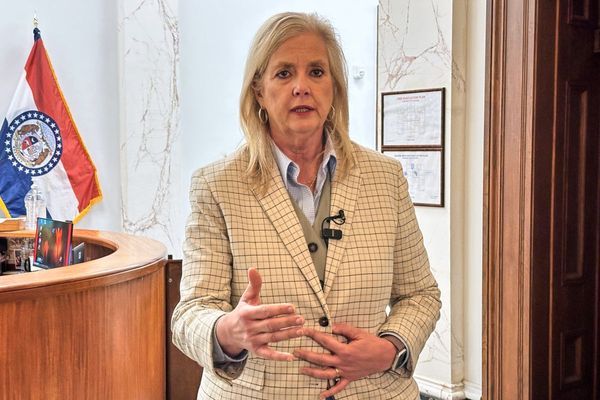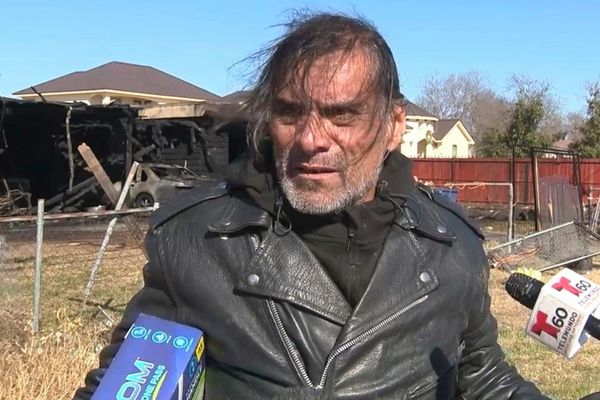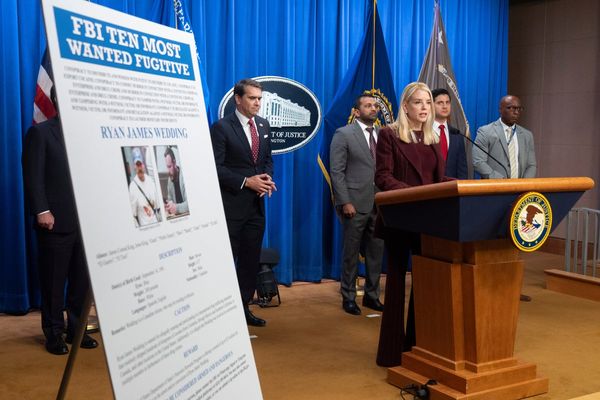
Speaking to the winner of the annual Observer/Faber graphic short story prize is always a highlight of my year, but this time around the experience was especially lovely. Lesley Imgart, whose brilliant broomstick-ridden story Witch Way? we publish today, has entered the competition five times in the past six years, and when she talks to me from her home in Edinburgh, she still sounds amazed finally to have triumphed. “It’s unbelievable,” she says. “It was this thing I just did every year… I keep forgetting I’ve won, and then 15 minutes later, I’ll remember, and feel pleased all over again.” Her verdict on herself: “I am nothing if not persistent.”
Imgart’s story is about the life of a young witch. First, comes witch school, and the struggle to concentrate on maths when she’d rather be casting spells. Then, university (Contemporary Magic Practice BA Hons at the College of Arcane Arts). But what to do with her life once she graduates? Even witches need to earn a living. While her friends all seem gung-ho (“I’m going to focus on my YouBroom career,” says one, mobile phone already in front of his face), she ends up listening to customers’ complaints in a magical hardware shop (“Your self-stirring spoons stir too fast!”). Her magic is on the back burner, performed only for family and friends, or at weddings and birthdays, mainly because it’s cheaper than buying a present.
Imgart is not a witch, but the story is broadly autobiographical. “It’s a parody of the self-indulgent comics of my 20s, all those coming-of-age struggles,” she says. “But it was also inspired by Terry Pratchett’s Discworld books, the whole series of which I read last year.” At 28, and a trainee in the production department of a Scottish animation studio, the days when she worked in a warehouse are now behind her, she hopes. But who knows what the future holds? “I take this as encouragement to carry on [with comics]. I’ve so many ideas for things I think I can do. But I’m also so content right now… I mean, this week especially.” She laughs. “Maybe I am a bit like the witch in my story. As she says: I’ll [have to] figure it out.”
Imgart is German. She moved to the UK for art school in Birmingham, where she studied for a BA in illustration. After that came the warehouse years, and then she moved to Edinburgh to do a master’s degree, also in illustration. She didn’t, she says, grow up reading comics; her interest in the form didn’t begin until Isabel Greenberg, a former winner of the prize, came to Birmingham to give a talk to students. “I began reading graphic novels quite begrudgingly,” she says. “I like Kate Beaton [the award-winning Canadian author of Hark! A Vagrant] and Noah Van Sciver [the American cartoonist best known for his book Fante Bukowski], but it was Alison Bechdel [Fun Home] who convinced me that comics are an art form.”
Joining me as judges of the 2024 prize were, as always, Angus Cargill, publishing director at Faber, our partner; Paul Gravett, wraparound expert on all things cartoon and the director of Comica; and Tom Oldham of Gosh! in Soho, London’s best comic book shop. Our brilliant guests were the author-artists Luke Healy and Posy Simmonds, who judged the prize in 2007, the year it launched (how lovely to have her back). On the day, our discussions were gentle: Imgart ultimately rose to the top of our shortlist of six with ease. However, two things struck us: the first, relatively benign, was the influence of Alice Oseman’s bestselling young adult Heartstopper series on some younger entrants. The second, more worryingly, was the possible (even probable) deployment of AI by some artists. We frowned on this, and will be vigilant about its use in future years.
This year’s runner-up, whose entry you can read online, is Elly Bazigos, who lives in Coventry, where she works as a full-time freelance illustrator (she did her illustration degree in Leeds). Her story LANSA Flight 508 was marked out by both its beautifully lush and detailed pictures, and by its subject matter – for, as its title suggests, it is inspired by an infamous plane crash of 1971, the sole survivor of which was 17-year-old Juliane Koepcke; having landed in the rainforest – the plane was flying from Lima to Iquitos in the Peruvian Amazon – she survived for 11 days until she was rescued by lumberjacks.
“I’m so chuffed,” Bazigos says. “I haven’t had much confidence in myself as a storyteller – I mean as an author as well as an illustrator – and this is so encouraging. Though I still feel like an impostor.” Like Imgart, she wasn’t much of a reader of comics as a child (though she was a fan of Terry Deary’s Horrible Histories series). But at university, she met people who did like them, and she began sketching her daily diary: a therapeutic experience for her eyes only. Why did she decide to draw a comic about flight 508? “I like stories about real people,” she says. “But it was Werner Herzog’s documentary about the crash, Wings of Hope, that really captured my imagination. For some reason I related to Juliane Koepcke. I began drawing immediately, but I also did a lot of research: I read her autobiography, and I picked out species of animals, plants and insects she mentioned, because in my pictures, I wanted to honour the rainforest.”
The judges thought she pulled this off. Her entry pays rereading. Each time you do so, you notice another creature, hidden in all that foliage. Its shades of green don’t only work to tell Koepcke’s miraculous story; they speak to a vital wild space now greatly under threat (Koepcke went on to become an entomologist, and to follow in her father’s footsteps as the director of Panguana, a Peruvian conservation project). Congratulations to both Bazigos and to Imgart from me and all the other judges – and I hope you enjoy their work.
* * *
Meet the judges
Luke Healy
Author of graphic novels including Americana (And the Act of Getting Over It.), The Con Artists and, most recently, Self-Esteem and the End of the World (Faber)
Did judging the competition take you back to your own start as a cartoonist, and if so, in what way?
It made me reminisce about my early days in art school more than anything. I’d already been making comics for a few years, but always ended up with failed attempts at sprawling epics. Then I went to the Center for Cartoon Studies, where we were drilled endlessly on making short, self-contained comics. Reading everyone’s four-page entries made me want to create a few short comics myself!
What did you make of the standard of the entrants? What was the most common mistake?
I certainly enjoyed reading through the entries, and there was a huge variety in terms of style and quality. I would say that the most common mistake I saw was a lack of attention to clarity for the reader. In comics, we aren’t really drawing, we are writing with pictures – so making sure everything is clear and readable should be a top priority.
Our winner, Witch Way?, is about the uncertain feeling of being young and how to make your way in the world (as well as about magic). Why did you feel it was a worthy winner?
To me, Witch Way? was the most polished and self-assured entry. It had a clear, simple idea (important for such a short story) and it explored that idea with simple, explicit emotions. The art was charming, and I imagine a lot of artists can relate to the sucking void of post-art-school doubt, myself included!
Which cartoonists inspired you early in your career, and who do you have your eye on now?
Two of my biggest early influences were Pascal Girard, a cartoonist from Quebec who is a master of awkward humour, and Ulli Lust, an Austrian cartoonist whose memoir Today Is the Last Day of the Rest of Your Life still firmly ranks as my favourite book of all time. Lately, I have been obsessed with humour cartoons from the New Yorker – particularly stuff from the 1950s and 60s from artists like Charles Addams and Whitney Darrow Jr. A recently published graphic novel that I loved was Tender by Beth Hetland – a truly creepy tale of social media addiction.
Posy Simmonds
Author of books including Gemma Bovary and Tamara Drew. A major retrospective of her work was held last year at the Pompidou Centre in Paris. At the 2024 International Comics festival in Angoulême she received the Grand Prix (for lifetime achievement), the first time a British artist has ever won the award
You are a returning judge. What did you make of this year’s entrants? Did their work make you feel stern or indulgent?
I think I was sternly indulgent. Drawing a two- or three-page narrative is difficult. First, finding the idea and then juggling the elements – plot, characters, images, text and dialogue – so that they form a coherent story, with a beginning and an end. All the entrants on the short list produced engaging work and in several cases the standard of the artwork was very high.
What was the most common pitfall?
The lack of a story, or, if there was a story, the lack of planning. Sometimes the plots were baffling. Sometimes an entrant would spend energy on an elaborate beginning, after which the idea would tail away.
The journey to become a fully fledged cartoonist/writer of graphic novels isn’t straightforward. How did you get your own start, and what advice do you have for our winner as they press on?
After leaving art college in 1968, I spent several months lugging my portfolio round the offices of newspapers and magazines. Eventually, there were small commissions, illustrating newspaper articles. The deadlines were tight, there was no time for second thoughts, but it was excellent training. My drawing hand became freer; I learned how to concentrate.
My advice would be to draw every day and always have a notebook with you. August is often a very good month for finding freelance work. People go on holiday, but papers and magazines always have pages to fill.
Did you read comics as a child?
Yes. British comics, including Beano, Dandy, Topper, Eagle and Girl. And many US comics, passed on by American children in the village where I grew up. These included Superman, Caspar the Friendly Ghost, Blondie & Dagwood and, from time to time, horror comics.
What’s the best graphic novel you’ve read recently, and why?
Final Cut by Charles Burns. Original, obsessive, weird… and with terrific artwork.
If you had to press two or three books on someone who hadn’t read any long-form comics before, what might they be, and why?
Persepolis (Vol 1) by Marjane Satrapi. A powerful memoir of Iran during the Islamic revolution and Satrapi’s childhood struggle with fundamentalism. Persepolis is as pertinent now as it was when first published more than 20 years ago. Raymond Briggs’s Ethel & Ernest tells the story of his parents’ lives, which spanned the upheavals of war and social change in the last century. Bittersweet, very funny and beautifully drawn.







